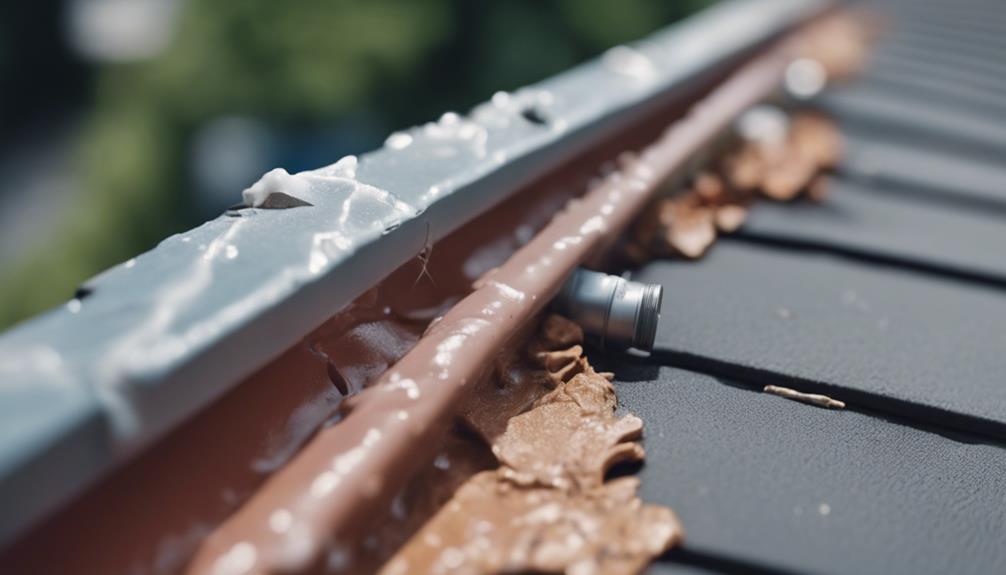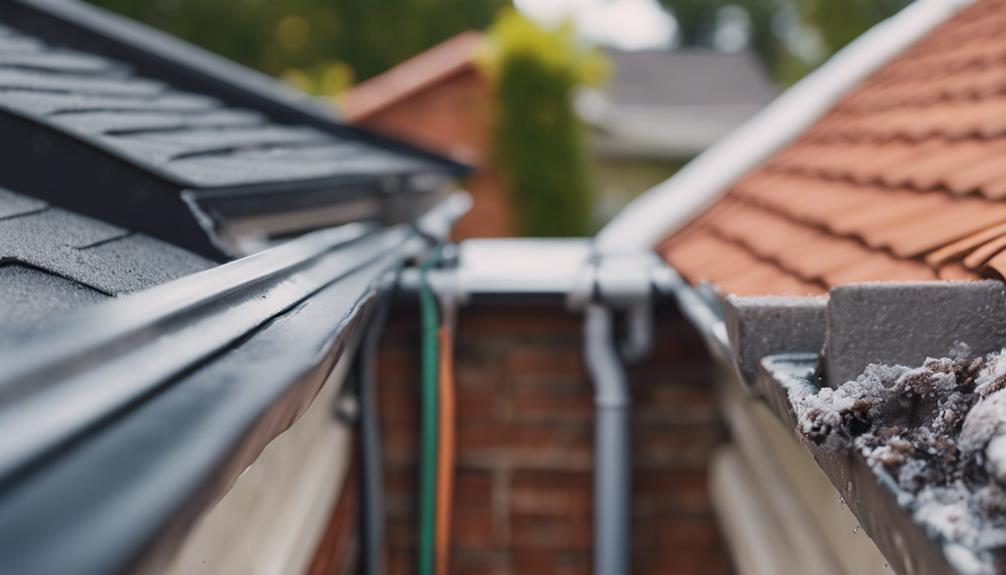Types of Gutters and Their Repair Needs
Understanding the distinct characteristics and maintenance requirements of various gutter types can have a profound impact on the longevity and functionality of a property’s drainage system.
From the challenges posed by sectional gutters to the common issues associated with seamless and vinyl alternatives, each type demands a tailored approach to repair and upkeep.
By exploring the nuances of these different gutter varieties and their specific repair considerations, property owners can equip themselves with the knowledge needed to address potential issues promptly and effectively.
Stay tuned to uncover the essential insights into safeguarding your property through informed gutter maintenance practices.
Sectional Gutters: Repair Challenges
When addressing repair challenges with sectional gutters, it is crucial to carefully assess the extent of damage and the specific areas that require attention. Sectional gutters are prone to issues such as leaks at the joints, sagging, and misalignment.
To fix leaks, start by thoroughly cleaning the gutter and applying a high-quality silicone sealant to the leaking joint. For sagging or misaligned gutters, reposition the hangers or add more to provide better support.
When replacing damaged sections, make sure to measure accurately and use compatible materials to guarantee a proper fit. Gutter joint repairs often involve resealing or replacing the connectors.
To prevent future repairs, consider installing gutter guards to keep debris out and maintain regular cleaning schedules. By addressing these repair challenges promptly and effectively, you can prolong the lifespan of your sectional gutters and prevent more significant issues down the line.
Seamless Gutters: Common Issues
Seamless gutters, despite their numerous advantages, may encounter common issues that necessitate prompt attention and expert solutions. One of the most frequent problems with seamless gutters is clogging due to leaves, debris, or even bird nests. This obstruction can disrupt the flow of water, leading to water overflow, which in turn can cause damage to the gutter system and the property’s foundation. Regular cleaning and maintenance can prevent this issue.
Another issue that seamless gutters may face is leaking at the seams. Although seamless gutters have fewer seams than traditional sectional gutters, the joints where they meet can still be vulnerable to leaks over time. These leaks can result from improper installation, wear and tear, or corrosion. It is important to address these leaks promptly to prevent water damage and mold growth.
Additionally, seamless gutters can experience sagging or misalignment, especially if they were not installed correctly or if they bear excess weight from debris accumulation. Proper installation and periodic inspections can help identify and rectify these issues before they escalate into more significant problems.
Vinyl Gutters: Repair Considerations

Addressing maintenance and repair needs for vinyl gutters involves a thorough understanding of their unique characteristics and potential issues, building upon the considerations faced with seamless gutters.
Vinyl gutters are lightweight, easy to install, and resistant to rust and corrosion, making them a popular choice for homeowners. However, they are prone to cracking in extreme temperatures and can become brittle over time. When repairing vinyl gutters, it is vital to inspect for cracks, holes, or sagging sections that may be causing leaks or improper drainage.
Repair considerations for vinyl gutters often include patching small cracks with specialized sealants or adhesives designed for vinyl materials. For more extensive damage, such as large cracks or holes, replacing the damaged section may be necessary to guarantee proper functionality. Additionally, reinforcing sagging or misaligned sections with hangers or brackets can help maintain the gutter’s structural integrity.
Regular cleaning and inspection can prevent debris buildup and prolong the lifespan of vinyl gutters, reducing the need for extensive repairs in the future.
Identifying Gutter Repair Needs
Identification of gutter repair needs is an important step in maintaining the functionality and longevity of your gutter system. To accurately identify repair needs, consider the following key aspects:
- Visual Inspection: Start by visually inspecting your gutters for any visible signs of damage such as cracks, holes, rust, or sagging sections. Look for water stains on the exterior walls which may indicate leaks.
- Gutter Performance: Observe how well your gutters are functioning during rainfall. Note any instances of overflowing water, poor drainage, or misaligned sections that may require attention.
- Gutter Joints: Check the joints between gutter sections for any signs of separation or leaking. Addressing issues with gutter joints promptly can prevent further damage to the system.
- Downspouts: Examine the downspouts for clogs or blockages that may impede proper water flow. Make sure that downspouts are securely attached to the gutters to prevent water from pooling near the foundation.
Addressing Specific Gutter Repairs

When encountering gutter repair needs, specific steps can effectively address common issues and guarantee the peak performance of the gutter system.
One common issue is leaks, which can often be fixed by resealing the seams with a waterproof sealant.
For sagging or misaligned gutters, it is essential to re-secure them to the fascia board using appropriate hangers or brackets.
In cases of damaged sections, replacement of the affected parts is necessary to maintain the integrity of the gutter system.
Repairing gutter joints may involve recaulking or replacing the joint altogether.
Additionally, implementing preventive measures such as installing gutter guards can help reduce the likelihood of future repairs by preventing debris buildup.
Regular inspections and maintenance are key to addressing specific gutter repairs promptly and ensuring the longevity of the gutter system. By following these steps diligently, homeowners can keep their gutters in peak condition and avoid more extensive issues down the line.
Frequently Asked Questions
What Are the Most Common Causes of Gutter Leaks and How Can They Be Prevented?
Gutter leaks commonly occur due to corrosion, poor installation, or clogs. Prevent them by regular maintenance, cleaning debris, inspecting for damages, and ensuring proper pitch. Installing gutter guards and repairing leaks promptly can also help prevent future issues.
Is It Possible to Repair Gutters on Your Own, or Is It Best to Hire a Professional?
When addressing gutter repairs, it’s important to assess the complexity of the issue. While some minor repairs like unclogging can be DIY tasks, intricate problems such as structural damage or joint issues are best left to professionals for efficient and lasting solutions.
How Do You Know When It’s Time to Replace Your Gutters Instead of Repairing Them?
When considering whether to replace gutters instead of repairing them, factors like extensive damage, frequent repairs, and age of the system should be assessed. Consulting with a professional can provide insight into the best course of action.
Are There Any DIY Maintenance Tasks That Can Help Prevent Gutter Damage and Repairs?
Regularly cleaning gutters, inspecting for debris buildup or blockages, securing loose fasteners, and ensuring proper drainage can prevent gutter damage and repairs. DIY maintenance tasks like these can help maintain gutter functionality and extend their lifespan.
What Are the Pros and Cons of Different Gutter Materials in Terms of Repair Needs and Longevity?
When considering gutter materials, durability, maintenance needs, and longevity play significant roles. Aluminum offers low maintenance but may dent easily, while steel is robust but prone to rust. Copper is highly durable but comes with a higher price tag. Proper installation and upkeep are essential for longevity.
